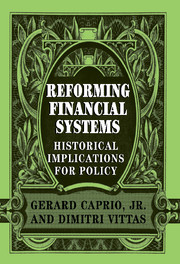Book contents
- Frontmatter
- Contents
- List of contributors
- Foreword
- 1 Financial history: Lessons of the past for reformers of the present
- 2 The evolution of central banking
- 3 Free banking: The Scottish experience as a model for emerging economies
- 4 Regulation and bank stability: Canada and the United States, 1870–1980
- 5 Deposit insurance
- 6 Contingent liability in banking: Useful policy for developing countries?
- 7 Universal banking and the financing of industrial development
- 8 Before main banks: A selective historical overview of Japan's prewar financial system
- 9 Thrift deposit institutions in Europe and the United States
- 10 The development of industrial pensions in the United States during the twentieth century
- 11 The rise of securities markets: What can government do?
- Index
9 - Thrift deposit institutions in Europe and the United States
Published online by Cambridge University Press: 25 March 2010
- Frontmatter
- Contents
- List of contributors
- Foreword
- 1 Financial history: Lessons of the past for reformers of the present
- 2 The evolution of central banking
- 3 Free banking: The Scottish experience as a model for emerging economies
- 4 Regulation and bank stability: Canada and the United States, 1870–1980
- 5 Deposit insurance
- 6 Contingent liability in banking: Useful policy for developing countries?
- 7 Universal banking and the financing of industrial development
- 8 Before main banks: A selective historical overview of Japan's prewar financial system
- 9 Thrift deposit institutions in Europe and the United States
- 10 The development of industrial pensions in the United States during the twentieth century
- 11 The rise of securities markets: What can government do?
- Index
Summary
The financial systems in most developing countries today have many features in common with the financial systems of the eighteenth and nineteenth centuries. Whether they had unlimited liability (as in Scotland in the eighteenth century), double liability (as in the United States in the late nineteenth century), or limited liability and special charters, commercial banks were the dominant institutions in the financial systems of European countries and the United States. Moreover, they were typically established by wealthy people and oriented toward businesses and other wealthy people – they effectively represented “banking for the rich by the rich.” Insurance companies were underdeveloped and pension and mutual funds did not yet exist. As a result middle- and low-income people had limited access to formal financial services and relied on informal arrangements for borrowing. Meanwhile, their financial savings were unproductively hoarded under the mattress.
This gap in the provision of financial services can be explained by the low level and unequal distribution of income and wealth, high information and transaction costs, and weak enforcement mechanisms – features that are found in most developing countries today. But over time, different types of institutions, including savings banks, credit cooperatives, building societies, and credit unions, emerged in the United States and Europe to overcome these problems and fill this market gap. This chapter gives a brief historical review of the emergence and evolution of thrift deposit institutions in Europe and the United States and draws lessons for today's developing countries.
- Type
- Chapter
- Information
- Reforming Financial SystemsHistorical Implications for Policy, pp. 141 - 179Publisher: Cambridge University PressPrint publication year: 1997
- 4
- Cited by



